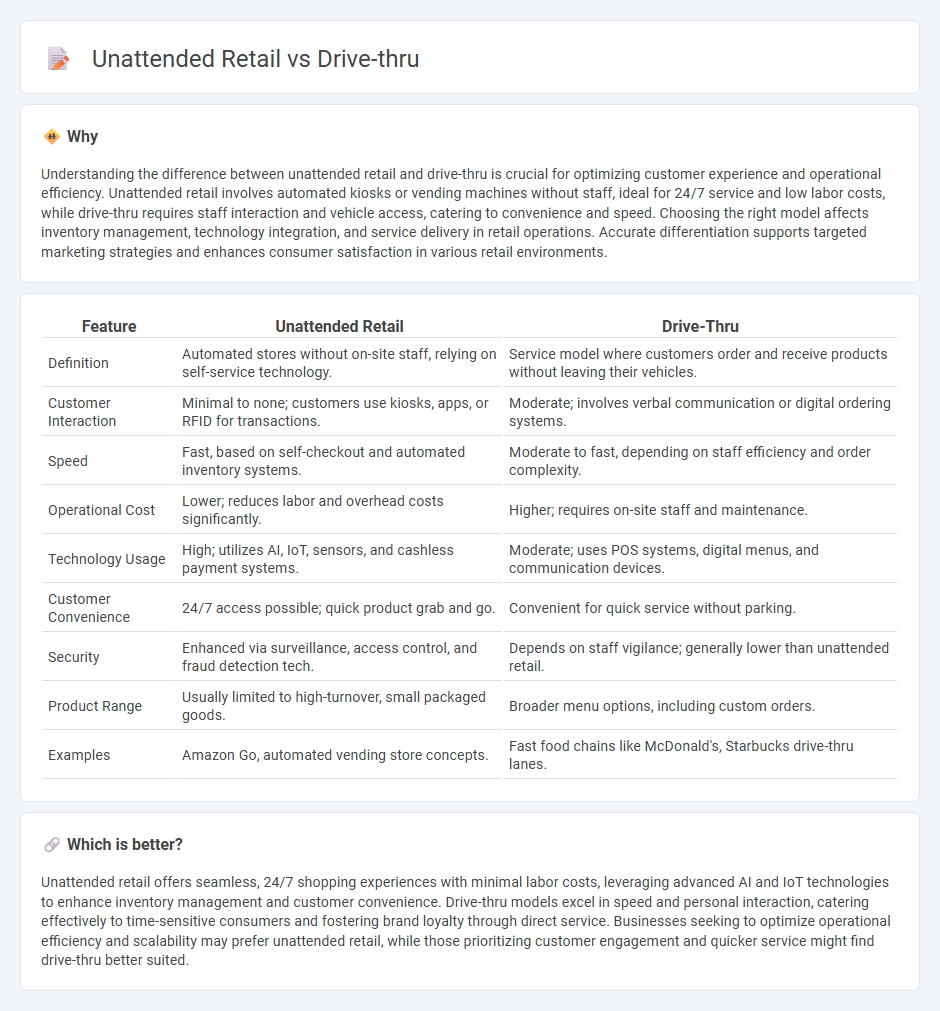
Unattended retail leverages automated kiosks and vending technologies to provide quick, self-service shopping experiences without the need for staff, enhancing convenience and reducing labor costs. Drive-thru retail combines car-friendly design with swift ordering and payment systems, catering to on-the-go customers seeking speed and minimal interaction. Explore how these innovative retail models are transforming consumer habits and operational efficiencies.
Why it is important
Understanding the difference between unattended retail and drive-thru is crucial for optimizing customer experience and operational efficiency. Unattended retail involves automated kiosks or vending machines without staff, ideal for 24/7 service and low labor costs, while drive-thru requires staff interaction and vehicle access, catering to convenience and speed. Choosing the right model affects inventory management, technology integration, and service delivery in retail operations. Accurate differentiation supports targeted marketing strategies and enhances consumer satisfaction in various retail environments.
Comparison Table
| Feature | Unattended Retail | Drive-Thru |
|---|---|---|
| Definition | Automated stores without on-site staff, relying on self-service technology. | Service model where customers order and receive products without leaving their vehicles. |
| Customer Interaction | Minimal to none; customers use kiosks, apps, or RFID for transactions. | Moderate; involves verbal communication or digital ordering systems. |
| Speed | Fast, based on self-checkout and automated inventory systems. | Moderate to fast, depending on staff efficiency and order complexity. |
| Operational Cost | Lower; reduces labor and overhead costs significantly. | Higher; requires on-site staff and maintenance. |
| Technology Usage | High; utilizes AI, IoT, sensors, and cashless payment systems. | Moderate; uses POS systems, digital menus, and communication devices. |
| Customer Convenience | 24/7 access possible; quick product grab and go. | Convenient for quick service without parking. |
| Security | Enhanced via surveillance, access control, and fraud detection tech. | Depends on staff vigilance; generally lower than unattended retail. |
| Product Range | Usually limited to high-turnover, small packaged goods. | Broader menu options, including custom orders. |
| Examples | Amazon Go, automated vending store concepts. | Fast food chains like McDonald's, Starbucks drive-thru lanes. |
Which is better?
Unattended retail offers seamless, 24/7 shopping experiences with minimal labor costs, leveraging advanced AI and IoT technologies to enhance inventory management and customer convenience. Drive-thru models excel in speed and personal interaction, catering effectively to time-sensitive consumers and fostering brand loyalty through direct service. Businesses seeking to optimize operational efficiency and scalability may prefer unattended retail, while those prioritizing customer engagement and quicker service might find drive-thru better suited.
Connection
Unattended retail leverages automated technology to facilitate seamless, cashless transactions without staff, while drive-thru services enhance convenience by allowing customers to quickly pick up goods without leaving their vehicles. Both models prioritize speed, efficiency, and minimal human interaction, meeting consumer demands for contactless and time-saving retail experiences. Integration of unattended retail systems in drive-thru setups optimizes order accuracy and reduces wait times, driving innovation in the retail sector.
Key Terms
Customer Interaction
Drive-thru services offer real-time customer interaction through face-to-face or audio communication, enhancing personalized service and immediate feedback. Unattended retail relies on automated systems, such as kiosks or vending machines, minimizing human contact but streamlining the purchasing process. Explore how each model impacts customer satisfaction and operational efficiency to determine the best fit for your business needs.
Automation
Drive-thru automation enhances customer experience by integrating AI-powered order processing and contactless payment systems, reducing wait times and labor costs. Unattended retail leverages IoT sensors and computer vision to enable seamless product selection and real-time inventory management without staff presence. Explore how these technologies are revolutionizing retail efficiency and customer convenience.
Convenience
Drive-thru offers rapid service by allowing customers to pick up orders without leaving their vehicles, ensuring time efficiency and minimal interaction. Unattended retail leverages technology like automated kiosks and smart vending machines to provide 24/7 access and seamless shopping experiences without staff presence. Discover how these models redefine convenience and transform consumer behavior in modern retail.
Source and External Links
Drive-through - A drive-through or drive-thru is a type of take-out service provided by a business that allows customers to purchase products without leaving their cars.
12 Drive-Thrus You Should Check Out in Dallas - This article showcases various local drive-thrus in Dallas that offer food service where customers remain in their cars, including unique setups beyond typical fast food chains.
McDonald's Drive Thru - McDonald's drive-thru service allows for speedy, contactless ordering at their locations, with features like mobile app rewards redeemable through the drive-thru.
 dowidth.com
dowidth.com